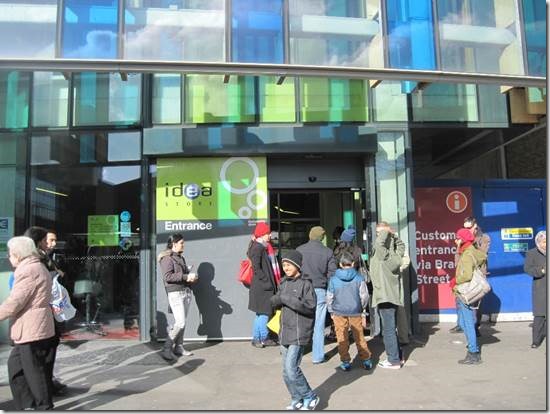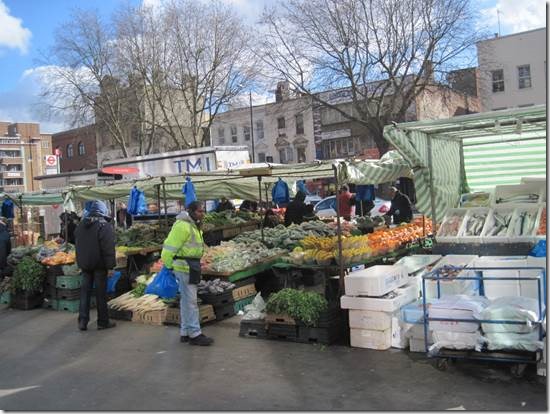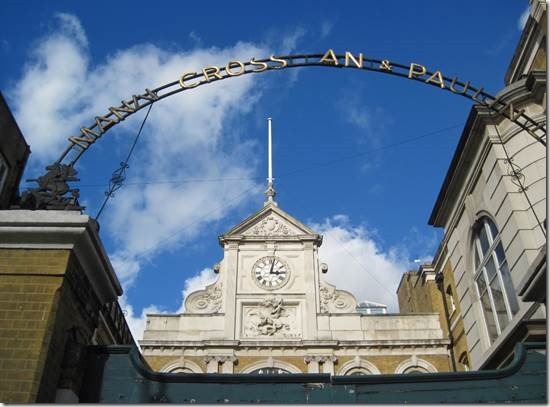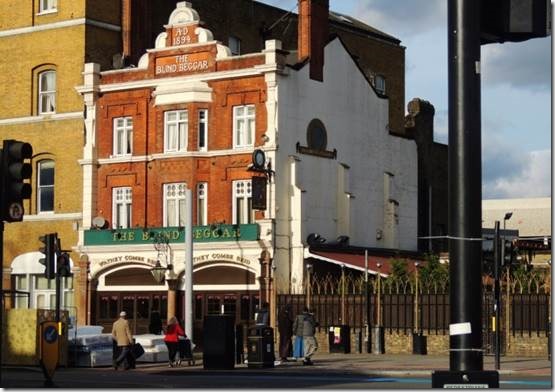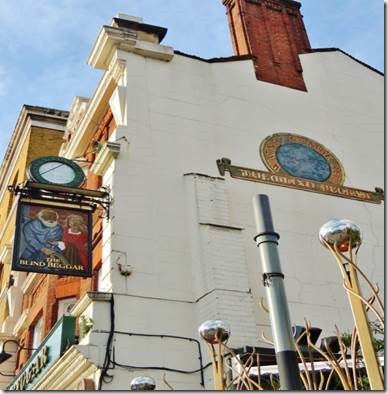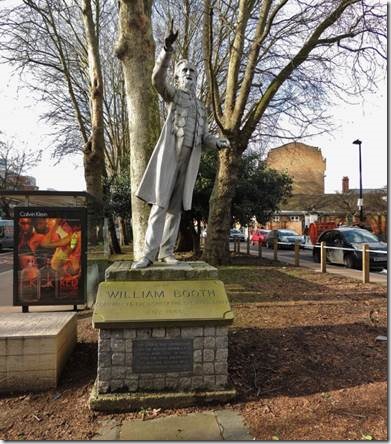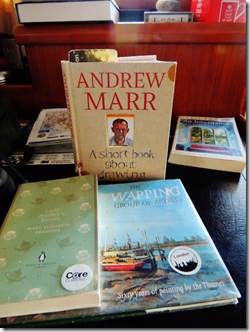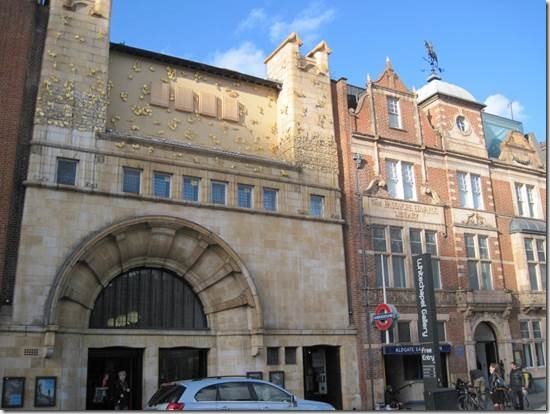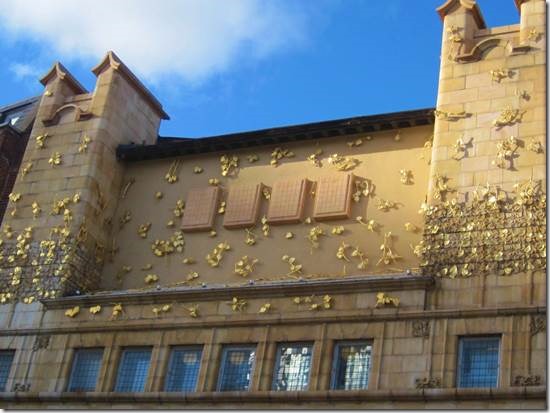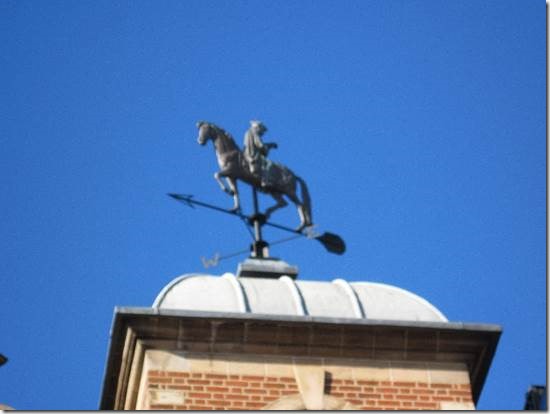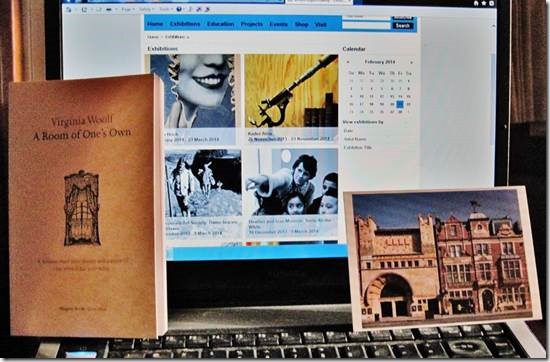Cheers.
“In mitn derinnen “ was the expression I remember my mother saying when, right in the middle of something, I did something else. That’s what I’m doing now as in ‘the middle of all the stories I’m in the middle of writing, now I’m going to write this new one instead. My visit Friday to the Ideastore Library Whitechapel and the Whitechapel Gallery.
Ru
|
After the fire alarm…… Photos inside libraries are really discouraged; reading privacy and all that. I took this one while we waited for the fire department to make sure there really wasn’t a fire. Of course, when the alarm rang, I was on the top floor (5 stories up but here called the 4th as they call the bottom floor “ground” ) so had to walk down knowing I’d have to walk back up when we were allowed back in. When the alarm first sounded everyone just sort of ignored it thinking someone must have gone out a fire door and set it off. But it kept going so more folks started collecting their things. I was just getting mine when a staff member came and asked us all, “don’t you hear the alarm?!” So we walked down the 5 flights of stairs at a speed far too slowly had there really been a fire. The cause of the alarm? It pains me to say this, but some really “naughty” (library staff’s word) woman was smoking in a Lady’s Loo and set off the smoke alarm. Thankfully the sun was out and it only took about 20 minutes before we were allowed back inside…to walk up the 5 flights as there was a long queue for the elevator. Art books are on the top floor as well as the small café. |
|
Street vendors line parts of Whitechapel Rd. Across from the library and for several blocks along Whitechapel are the fruit, veggie and fish sellers. I bought some Brussels Sprouts because they wouldn’t crush in my backpack on the way home. So much cheaper than the upscale Waitrose across from St Katharine Docks. And more fun! |
|
While waiting for the “all clear” I took the photos of the building next door which I sort of had read about from a previous walk along this route ( that I haven’t written up yet….yada yada yada.) Albion Brewery Building http://www..eastlondonpostcard.co.uk/POM2004/Aug04.htm HISTORY: The main Albion Brewery (this building next to the library) was further west on Whitechapel Road and began trading in 1808. The surviving buildings on the main site date from the 1860s and c1902-5 and are Grade II-listed. It was the Edwardian period that gave the brewery its most striking buildings, in particular the remodelled fermenting house which has a pedimented gable set between carved volutes, clock and a carved relief of St George and the Dragon, in what the Buildings of England volume for East London describes as a ‘show-off Baroque style’. The architects were William Bradford and Sons, a firm which specialised in highly-decorative brewery architecture, and who may have also designed the building at 27a Mile End Road. Certainly the stylistic tag applies equally well here. The first resident was Brewery Engineer William George Bartle, but the building also functioned as a distribution centre for barrels of beer. A motor trolley shed with a steel truss roof and ridge lighting was also built in 1905, accessed through the large central carriage arch to the house. At that time there was stabling and cart sheds dating to the 1880s to the rear of the new buildings. Shire horses were still the principal means of distributing barrels, but in 1904 the brewery had purchased its first ‘motor carriage’ and the new motor trolley shed was no doubt built in anticipation of growing use of motorised transport in place of dray horses. In 1941 a bomb killed twenty-five horses, seriously damaged the stables and sheds, and removed the roof of the main building at 27a Mile End Road. The roof was presumably patched up until 1984, when the building was refurbished and a mansard and gable added to the upper storey. The motor trolley shed, old stabling and cart sheds were considered too badly damaged for repair, however, and demolished. Their sites were redeveloped with residential blocks by Proctor Matthews in 1999-2000. SOURCES: Tower Hamlets Local History Library, Drainage Application Plan dated 21 July 1905 H Janes, Albion Brewery 1808-1958 (c1958) 80-81 Goad Insurance Plans REASONS FOR DESIGNATION: The former brewery engineer’s house is listed at Grade II for the following principal reasons: * of special architectural interest as a flamboyant and richly-detailed building in the Edwardian Baroque style with mannerist touches; * high-quality stonework used generously and to good effect; * the building is sensitive to its context, with its upper storeys set back to respect the scale of the neighbouring C17 Trinity Almshouses and the cartouches on the arches referencing the style of these highly-significant buildings; * historic association with the main Albion Brewery buildings on Whitechapel Road, which are Grade II-listed. http://www.rightmove.co.uk/property-for-sale/property-37021079.html ad for a £279.995 1 bedroom flat in this building. The photos made it look quite nice and just next door to the library, Sainsburys supermarket around the corner, fruit and vegies right outside and the Whitechapel Tube station steps away. And 1/3 the price of flats overlooking the Thames! |
|
The Blind Beggar pub next door to the Albion Brewery Blind Beggar Signboard http://theblindbeggar.com/index.php/the-history tells the history on their website, but not as completely as my Folklore of British Pub Names book. The version below is the most similar and comes from a site explaining the coat of arms of Bethnall Greene, the area of London where the pub is located. (Bethnall Green is also part of Tower Hamlets as is St Katharine Docks Marina.) “The borough had no [coat of] arms, but the design of the Common Seal adopted by the Council bears reference to the apocryphal legend of The beggar’s daughter of Bednall Greene, a lengthy poem which appeared in Percy’s Reliques of ancient English poetry in 1765, and was probably written in Elizabethan times. The story tells how Henry, son and heir of Simon de Montfort, believed to have fallen at Evesham in 1265, was found and nursed by a baron’s daughter, who he afterwards married. Henry, blinded in the battle, dressed as a beggar to escape King Henry’s spies. Later his daughter, "pretty Bessee", had four suitors at once – a knight, a gentleman of fortune, a London merchant, and the son of the innkeeper at Romford, and all (except the knight) cooled in their affections when told they must ask the consent of her father, the poor blind beggar of Bethnal Green. The knight, however, went and asked the beggar’s leave to marry his daughter and, unknowingly, gained a considerable dowry, Henry giving Bessie £3,000, and £100 to buy her wedding gown. At the wedding feast it was explained to the guests who Henry really was. The story, although almost certainly legend, enjoyed a wide vogue and must have had a basis in fact. Three plays on the subject are in existence, and printed versions have appeared in numerous editions. As far back as 1690 the theme was used as a decoration for the Beadle’s staff.” http://www.ngw.nl/heraldrywiki/index.php?title=Bethnal_Green “The pub is also the birthplace of the Salvation Army, as it was outside the public house which previously stood on the site that William Booth, founder of the organisation, gave his first open air sermon in 1865. The pub itself was built in 1894 on a site previously occupied by another inn. The pub is named after Henry de Montfort, a son of Simon de Montfort, the famous leader who called the first directly elected parliament in medieval Europe. Henry was apparently wounded and lost his sight in the Battle of Evesham in 1265, and used to beg at the crossroads, becoming referred to as the Blind Beggar of Bethnal Green. http://www.tiredoflondontiredoflife.com/2009/11/drink-at-blind-beggar.html And then there’s the modern day murder story connected to the Blind Beggar. http://www.murdermap.co.uk/ Tells the story of a modern day murder ala Hatfields and McCoys style. |
|
The statue of William Booth on Mile End Road just down from the Blind Beggar Pub was taken on a previous walk. I always thought of the Salvation Army as having begun in America. |
|
My books from the library and also one from the Spitafields Trust Charity Shop. I hadn’t checked out my books before the fire alarm but the kind library guard put them aside for me so I could retrieve them from the front desk. Lady Audley’s Secret by Mary Elizabeth Braddon first published in serial form in 1861 I like older novels. The Wapping Group of Artists: Sixty Years of Painting by the Thames for obvious reasons. A Short Book About Drawing by Andrew Marr which I will hate to ever finish! He talks about why drawing and painting makes him happy even when the particular piece he’s working on turns out “rubbish” as they say here where we’d say “crap.” And how drawing is both great fun and hard work “When most people are drawing or painting, under the quiet surface, there is a mental drama going on.” That captures exactly how I feel at my life drawing sessions. The Spitalfields Crypt Trust http://www.sct.org.uk/ has a charity shop where I can find at least one or two books interesting to me. The Inheritance by Caro Fraser who has both an art degree and law degree so isn’t so fluffy as her book covers might make you think. The books are cheap and the money goes to a good cause. And sometimes I need a TV substitute and this kind of book is just that. The interesting/obvious thing is that British libraries have more British authors/subjects not always available in US libraries so there are new authors/subjects to discover. Our Roanoke County Public Library does own Lady Audley’s Secret and Adrew Marr’s biography of Queen Elizabeth II, but not his art book or the book of Wapping Artists. Wapping is the area just east of us along the Thames. None of Caro Fraser’s books were in the Roanoke Valley Libraries either. Makes perfect sense when you think about it. Our regional authors probably don’t show up in British libraries either. |
|
Whitechapel Gallery and the former Passmore Edwards Library (replaced by the Ideastore Library) Whitechapel Art Gallery now expanded into the former Passmore Edwards Library. Listed Building. Gallery by Charles Harrison Townsend (1851-1928). Designed 1897, built 1898-9. Architectural faience cladding (glazed terracotta blocks), with some foliage-carving. Whitechapel High Street, London E1 7QX http://www.victorianweb.org/art/architecture/townsend/1.html http://www.whitechapelgallery..org/ free admission except for the special exhibitions. For over a century the Whitechapel Gallery has premiered world-class artists from modern masters such as Pablo Picasso, Jackson Pollock, Mark Rothko and Frida Kahlo to contemporaries such as Sophie Calle, Lucian Freud, Gilbert & George and Mark Wallinger. With beautiful galleries, exhibitions, artist commissions, collection displays, historic archives, education resources, inspiring art courses, dining room and bookshop, the Gallery is open all year round, so there is always something free to see. The Gallery is a touchstone for contemporary art internationally, plays a central role in London’s cultural landscape and is pivotal to the continued growth of the world’s most vibrant contemporary art quarter.” http://www.whitechapelgallery.org/about-us I enjoyed learning about the Acme Studios created from the derelict buildings in the area… http://www.whitechapelgallery.org But most of the Gallery’s art is art I’m not familiar with so less appealing to me than works at other museums. But the building is interesting! |
|
The gold leaves on the building’s façade were created by Rachael Whiteread “Inspired by the tenacious presence of urban plants like buddlea, which the artist calls ‘Hackney weed’, Whiteread has covered the leaves and branches in gold leaf, making them part of London’s rooftop repertoire of gilded angels, heraldic animals and crests.” http://www.whitechapelgallery.org/projects/rachel-whiteread tells how these leaves were created. There is a video interview as well. |
|
Weathervane on the Passmore Edwards building Rodney Graham’s copper and steel working Weathervane(2008) is permanently installed on the Gallery roof. It depicts the artist as the sixteenth century scholar, Erasmus, seated backwards on a horse while reading The Praise of Folly. http://www.whitechapelgallery.org/exhibitions/social-sculpture About the Passmore Edwards Library “Opened in 1892, an initiative of Sameul and Henrietta Barnett, and funded by John Passmore Edwards, it was the first free public library in Whitechapel. Open on Sunday afternoons to serve the local Jewish community, it became a place for study, homework and vibrant political discussion. Many early readers became famous, including writers Isaac Rosenberg, Bernard Kops and Arnold Wesker, mathematician Selig Frodetsky and child psychologist Jacob Fronowski. It housed a substantial Yiddish book collection, later replaced by books in Bengali and Somali. It closed in 2005, reopening nearby as an Idea Store. Many people mourned its closing and its significance was perfectly captured by Bernard Kops in his poem Whitechapel Library Aldgate East.” * see below From Jewish London by Rachael Kolsky and Roslyn Rawson
Passmore Edwards in the East End February 6, 2013 by Dean Evans “ At the time of cuts to libraries and other vital social resources, Dean Evans author of Funding The Ladder – The Passmore Edwards Legacy takes a timely look at the forgotten benefactor who shaped the culture of the East End through his enlightened philanthropy. ……Canon Samuel Barnett and his wife Henrietta moved to St Jude’s Parish, Whitechapel, in the eighteen seventies when it was an over-crowded area of appalling poverty and poor housing, mostly endured by Jewish immigrants from Eastern Europe. The Barnetts set about to improve the conditions of their parishioners with missionary zeal, believing that “the social problem is at root an educational one” and that Free Libraries were the best means of education. When the Whitechapel Library was formally opened in October 1892, there were already more than two and a half thousand people making use of the reading room on a daily basis and one thousand on Sundays. It had taken Barnett fourteen years to see his dream materialise of the first rate-supported library in the East End. For Passmore Edwards it was the beginning of a relationship with the East End that was to last until the end of his days and result in more than a dozen public buildings, libraries, hospitals, technical institutes, art galleries, boys clubs and a home for foreign sailors, all freely given to help those less fortunate…” http://spitalfieldslife.com/2013/02/06/passmore-edwards-in-the-east-end/ tells the story of the British Andrew Carnegie with interesting reader comments about the various Passmore Edwards libraries in their lives. |
|
In the Whitechapel Gallery book shop I bought a copy of Virginia Woolf’s A Room of One’s Own which I read years ago but want to read again. It’s just the right small size to carry around and read bits of when I’m waiting for Randal in a hardware store or chandlery. When we visit free venues I try to buy at least something to contribute back. They are resting against my computer screen advertising the exhibitions now at the Gallery. |
|
Bernard Kops was born in the East End of London. Since The Hamlet of Stepney Green (1959), he has written over 40 plays, nine novels, and seven volumes of poetry including Grandchildren and Other Poems (Hearing Eye, 2000). This poem on Whitechapel Library is reprinted here by kind permission of the poet and publisher. Bernard Kops will read from his work at the Nelson Street Synagogue on 4 September at 6pm. *Whitechapel Library, Aldgate East How often I went in for warmth and a doze The newspaper room whilst my world outside froze And I took out my sardine sandwich feast. Whitechapel Library, Aldgate East. And the tramps and the madman and the chattering crone. The smell of their farts could turn you to stone But anywhere, anywhere was better than home. The joy to escape from family and war. But how can you have dreams? you’ll end up on the floor. Be like your brothers, what else is life for? You’re lost and you’re drifting, settle down, get a job. Meet a nice Jewish girl, work hard, earn a few bob. Get married, have kids; a nice home on the never and save up for the future and days of rough weather. Come back down to earth, there is nothing more. I listened and nodded, like I knew the score. And early next morning l crept out the door. Outside it was pouring I was leaving forever. I was finally, irrevocably done with this scene, The trap of my world in Stepney Green. With nowhere to go and nothing to dream A loner in love with words, but so lost and wandering the streets, not counting the cost. I emerged out of childhood with nowhere to hide when a door called my name and pulled me inside. And being so hungry I fell on the feast. Whitechapel Library, Aldgate East. And my brain explodes when I suddenly find, an orchard within for the heart and the mind. The past was a mirage I’d left far behind And I am a locust and I’m at a feast. Whitechapel Library, Aldgate East. And Rosenberg also came to get out of the cold To write poems of fire, but he never grew old. And here I met Chekhov, Tolstoy, Meyerhold. I read all their worlds, their dark visions of gold. The reference library, where my thoughts were to rage. I ate book after book, page after page. I scoffed poetry for breakfast and novels for tea. And plays for my supper. No more poverty. Welcome young poet, in here you are free to follow your star to where you should be. That door of the library was the door into me And Lorca and Shelley said “Come to the feast.” Whitechapel Library, Aldgate East. Written by Writer ⋅ September 17, 2005 I’d often noticed the name Passmore Edwards Library on the building but only now do I know anything about it. |

